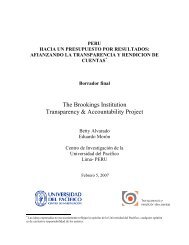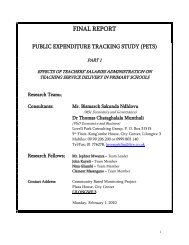Provider Purchasing and Contracting for Health Services_The Case
Provider Purchasing and Contracting for Health Services_The Case
Provider Purchasing and Contracting for Health Services_The Case
Create successful ePaper yourself
Turn your PDF publications into a flip-book with our unique Google optimized e-Paper software.
Executive Summary<br />
Objective <strong>and</strong> rationale of the study<br />
<strong>The</strong> objective of this study was to identify <strong>and</strong> characterize contracting models that have<br />
existed in the Zambian health sector <strong>and</strong> their consequences on access to health care. <strong>The</strong><br />
study was aimed at assessing the extent to which the identified contracting models have been<br />
successful in achieving their intended goals <strong>and</strong> at determining their potential to be scaled up<br />
to the entire health sector, including the private sector.<br />
Methods<br />
<strong>The</strong> study used both qualitative <strong>and</strong> quantitative approaches. <strong>The</strong> data were collected from<br />
both primary <strong>and</strong> secondary sources. A selected number of providers <strong>and</strong> policymakers were<br />
interviewed using a semi-structured questionnaire. Secondary data were collected using a<br />
structured questionnaire.<br />
Findings of the study<br />
<strong>The</strong> study reveals that contracting-in <strong>and</strong> contracting-out are prevalent in Zambia.<br />
<strong>Contracting</strong>-in is seen where the government is providing health service to the people on a<br />
wide scale. Different levels of the referral system within the public health sector contract with<br />
each other through the concept known as “purchase of beds.” <strong>Contracting</strong>-out is evidenced by<br />
the relationship existing between government <strong>and</strong> the faith-based organizations <strong>and</strong> not-<strong>for</strong>profit<br />
nongovernmental organizations where the latter are providing health services to the<br />
people on behalf of the government.<br />
Despite the conducive policy environment <strong>for</strong> contracting private <strong>for</strong>-profit health service<br />
providers, the study has established that direct contracting-out to the private <strong>for</strong>-profit health<br />
institutions has been very limited. This is evidenced by the fact that there are no contracts or<br />
exchange of financial resources between the government <strong>and</strong> private <strong>for</strong>-profit health<br />
institutions <strong>for</strong> health services. Moreover, the study observed that contracting-out to the<br />
private sector is constrained by limited budgets, attitudes of fund holders toward the private<br />
sector, lack of a comprehensive policy <strong>for</strong> harnessing the private sector, lack of a plat<strong>for</strong>m<br />
where policymakers in the Ministry of <strong>Health</strong> <strong>and</strong> the private sector interact, as well as the<br />
reluctance of the private sector to engage in a deeper interaction with the government.<br />
Although contracting-out is limited, partnerships between the private <strong>for</strong>-profit institutions<br />
<strong>and</strong> the government have thrived in public health programs as well as vertical programs. For<br />
example, in some isolated instances, the government does m<strong>and</strong>ate private <strong>for</strong>-profit health<br />
providers to carry out some services falling within public health programs such as the<br />
distribution of anti-retrovirals to people living with HIV <strong>and</strong> AIDS, child immunization, <strong>and</strong><br />
malaria control programs.<br />
Further, the study shows that with the abolishment of the Central Board of <strong>Health</strong>, the<br />
provider-purchaser split has now been merged into the Ministry of <strong>Health</strong> structures. Despite<br />
these changes, however, the contracting process remains the same, <strong>and</strong> evidence on the<br />
iv
















